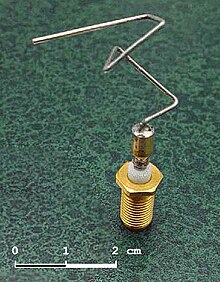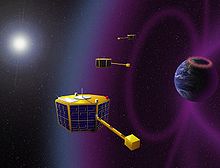Space Technology 5
Space Technology 5 (abbreviated to ST5 ) is a satellite project of the US space agency NASA as part of the New Millennium Program to test new space technologies. The mission consists of three small satellites that were launched on March 22, 2006 together with a Pegasus XL rocket. Using multiple small, inexpensive satellites introduced a new type of mission. Each of the satellites weighs 25 kg and is about the size of a medium-sized television. This brings the mission to a relatively low total cost of around 130 million dollars (including launch vehicle and mission implementation). The mission was scheduled to last at least 90 days. Secondly, it served to research and map the earth's magnetic field .
Mission objectives
The primary aim of the mission was to demonstrate the new technology of microsatellites (English micro-sats ) and to test it in space. Each of the three satellites is a completely independent system with its own navigation, propulsion and communication systems. State-of-the-art miniaturization technology was used. During the mission, the satellites were left to their own devices for a day to demonstrate and test automation technologies.
The scientific aim of the mission was to study the earth's magnetic field. The satellites should map the direction and strength of the internal magnetic field. The satellites fly in formation and, with their highly sensitive magnetometers, were able to carry out precise measurements simultaneously at several points in the earth's magnetic field. In the future, scientists want to be able to predict magnetic storms and other phenomena. These have devastating effects on communication in space and on earth and in extreme cases can even destroy satellites completely.
technology
The satellites have the shape of an octagon with a diameter of 53 centimeters and a height of 48 centimeters. To stabilize the flight position , the satellites rotate around their own axis at 20 revolutions per minute. The outer sides are covered with solar cells , which together cover the energy consumption of around 25 W. Here, a is lithium - accumulator used with a capacity of 7.9 Ah as a buffer.

The satellites work autonomously to a high degree; they are only radioed by the ground station two to three times a day for 10-30 minutes each time. During this time window, new commands are issued to the satellites and scientific data are received. This requires a large buffer and fast transmission. 20 megabytes of data can be stored on each satellite, the transmission rate is 100 kBps.
Data is transmitted over the X-band (7–8 GHz). An optimized antenna is used for this. Its shape was calculated on a high-performance computer using an evolutionary algorithm and is adapted to the mission's orbit. It thus guarantees a higher transfer rate with lower power consumption.
Instruments
The only scientific experiment on board the satellites is a miniaturized magnetometer . In order to protect it from interfering influences from the probe, it is attached to an aluminum boom that is extended after the start.
Mission history
Originally, the mission should have started on February 28, 2006. However, it had to be moved several times due to problems with the release device. The carrier machine then started on February 15, but had to turn back when the last checks revealed an error.
Space Technology 5 finally launched on March 22nd with a Pegasus XL . This launcher is launched from an aircraft from a height of 14,000 m. The launch was one of the smoothest in rocket history, according to NASA. Eleven minutes after the rocket detached from the aircraft, the first of the three satellites was launched into space, three minutes later the second and after another three minutes the third. The satellites were mounted on a payload adapter specially developed for this mission, which enabled the three satellites to be launched with a single rocket.
The satellites were deployed at an altitude of 300 km. Their polar orbit is very elliptical, the satellites are between 300 and 4,000 km altitude. They need 136 minutes for one orbit around the earth. They fly in formation and are about 350 km apart.
The satellites began transmitting data two hours after launch. They all work perfectly. About a month after the launch, all systems were activated and the satellites swiveled into their final flight formation. The small micro-thrusters, which are also new for the mission, were used for this purpose. The first scientific results were already available in April, and those responsible already spoke of a complete success of the mission. The mission was completed at the end of June and the satellites were switched off on June 30th.
See also
Web links
- Space Technology 5 website of the JPL (English)
- Space Technology 5 NASA (English)



